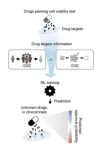(Press-News.org) Close relatives of people with metabolic-associated fatty liver disease have a higher risk of developing liver cancer and dying from liver-related diseases, according to a national study from Karolinska Institutet in Sweden published in The Journal of Hepatology. This means that family members could also benefit from the lifestyle advice that is currently only given to patients, the researchers conclude.
People with metabolic-associated fatty liver disease (MASLD, formerly known as NAFLD – see fact box) have an elevated risk of developing and dying from liver cancer. MASLD is now the main reason why the number of people developing liver cancer has risen so sharply. However, researchers at Karolinska Institutet now show that close relatives and partners also have an increased risk of developing liver cancer and advanced liver disease.
May benefit from early screening
“Our findings indicate that patients with MASLD should not be treated separately,” says the study’s first author Fahim Ebrahimi, doctor and researcher at the Department of Medical Epidemiology and Biostatistics, Karolinska Institutet. “Indeed, recommendations for lifestyle changes should be given to their family members as well. Our study also suggests that relatives with metabolic risk factors such as diabetes mellitus may benefit from early screening for MASLD.”
The researchers based their study on the ESPRESSO cohort, which contains data on all liver biopsies taken in Sweden from 1965 up to the present. They identified almost 12,000 people with biopsy-proven MASLD. After matching each person with up to five comparators from the general population they identified first-degree relatives (parents, siblings and children) and partners for both groups. The study included nearly 250,000 first-degree relatives and 57,000 partners.
Followed for up to 50 years
Over an average follow-up period of 17.6 years, with some individuals being followed for up to 50 years, the researchers found that first-degree relatives of MASLD patients were 80 per cent more likely to develop liver cancer than the controls. However, as liver cancer is a relatively rare disease, the absolute increase in risk is much lower: 0.11 per cent over 20 years, according to the researchers.
“In other words, one in every 900 first-degree relatives of patients with MASLD will additionally develop liver cancer over a 20-year period,” says senior author Jonas F. Ludvigsson, professor at the Department of Medical Epidemiology and Biostatistics, Karolinska Institutet. “So, the absolute risk is very small, but still relevant at a population level.”
Shared lifestyle is an important factor
The researchers also found that partners of patients with MASLD were more likely to develop severe liver disease (such as cirrhosis) and to die from liver-related causes.
“Our findings confirm that there is a clear familial risk of MASLD and that a shared lifestyle is an important factor in its development,” says Dr Ebrahimi.
The study was financed by the Swiss National Science Foundation (SNSF) and Karolinska Institutet. Fahim Ebrahimi and coauthors Hannes Hagström and Jonas F. Ludvigsson have all had financial ties to various pharmaceutical companies, primarily in the form of research grants for unrelated studies and consultancy fees.
Facts: It is estimated that one in four adults worldwide is affected by MASLD (metabolic dysfunction-associated steatotic liver disease), previously known as NAFLD (nonalcoholic fatty liver disease). However, the vast majority are unaware of their condition. The challenge for healthcare services is to find the small number of people who go on to develop more serious liver disease, such as fibrosis, cirrhosis or cancer. Finding ways to identify those at greatest risk is therefore a priority and the present study shows some easily identifiable risk groups. Source: Fahim Ebrahimi
Publication: “Familial Coaggregation of MASLD with Hepatocellular Carcinoma and Adverse Liver Outcomes: Nationwide Multigeneration Cohort Study”, Fahim Ebrahimi, Hannes Hagström, Jiangwei Sun, David Bergman, Ying Shang, Wen Yang, Bjorn Roelstraete, Jonas F. Ludvigsson, Journal of Hepatology, online 28 August 2023, doi: 10.1016/j.jhep.2023.08.018.
END
Liver cancer and severe liver disease more common if a close relative has fatty liver disease
2023-09-08
ELSE PRESS RELEASES FROM THIS DATE:
Bees struggle to find flowers because of air pollution
2023-09-08
A new study has found that air pollution is preventing pollinators finding flowers because it degrades the scent.
A research team comprising the UK Centre for Ecology & Hydrology (UKCEH) and the Universities of Birmingham, Reading, Surrey and Southern Queensland, found that ozone substantially changes the size and scent of floral odour plumes given off by flowers, and that it reduced honeybees' ability to recognise odours by up to 90% from just a few metres away.
Ground-level ozone typically forms when nitrogen oxide emissions from vehicles and industrial processes react with volatile organic compounds emitted from vegetation ...
Study shows food from tobacco-owned brands more 'hyperpalatable' than competitor's food
2023-09-08
LAWRENCE — Many of us know all too well the addictive nature of many foods marketed in the United States — most call it “junk food.” In fact, this kind of salty, sweet and high-fat fare makes up the lion’s share of what’s marketed to Americans.
Researchers employ a more scholarly term for food items featuring purposely tempting combinations of salts, fats and sugars: They’re “hyperpalatable.”
Now, an investigator at the University of Kansas has conducted research showing food brands owned by tobacco ...
What do neurons, fireflies and dancing the Nutbush have in common?
2023-09-08
Computer scientists and mathematicians working in complex systems at the University of Sydney and the Max Planck Institute for Mathematics in the Sciences in Germany have developed new methods to describe what many of us take for granted – how easy, or hard, it can be to fall in and out of sync.
Synchronised phenomena are all around us, whether it is human clapping and dancing, or the way fireflies flash, or how our neurons and heart cells interact. However, it is something not fully understood in engineering and science.
Associate Professor Joseph Lizier, expert in complex systems at the University of Sydney, said: “We know ...
Drug approvals in clinical trials were correlated with the cells/humans discrepancy in gene perturbation effects
2023-09-08
Developing new drugs is paramount in discovering innovative treatments and preventing diseases. This is vital not only for advancing medicine but also for the overall health and well-being of humanity. Yet, even when drugs demonstrate safety and efficacy in cell and animal models, they frequently encounter hurdles in clinical trials on human.
A single setback for a drug during clinical trials, which involves diverse population groups, can result in significant economic losses. To address this, it is imperative to understand why certain drugs, despite passing the preclinical stages, falter during clinical ...
Unveiling the causes of the 1931 Yangtze River Deluge
2023-09-08
In the summer of 1931, an unprecedented calamity unfolded along the Yangtze River basin in eastern China - the 1931 Yangtze River flood, known as one of history's deadliest natural disasters. This cataclysmic event submerged a staggering 180,000 km2, affected 25 million lives, and tragically claimed over 2 million lives.
Despite its immense societal impact, the origins of this monumental flood have remained largely unexplored, a challenge compounded by the scarcity of historical records and pre-1950s meteorological data in China. Recent access to crucial historical datasets has, however, unlocked the ability to investigate the 1931 Yangtze River flood.
A recent study published ...
Physical activity boosting resources support classroom performance
2023-09-08
DALLAS, September 8, 2023 — This back to school season the American Heart Association and the National Football League (NFL), in collaboration with its 32 NFL clubs, are offering students exciting ways to move more with NFL PLAY 60™. Physical activity is important as students return to the classroom. According to the U.S. Department of Health and Human Services’ 2018 Physical Activity Guidelines for Americans, active kids learn better, focus more, think more clearly, react to stress more calmly, and perform and behave better in the classroom[1].
The ...
New study highlights feasibility and optimization of ammonia-based power generation for carbon neutrality
2023-09-08
Ammonia is emerging as a promising energy source to achieve carbon neutrality due to its inherent carbon-free nature. A recent study, led by Professor Hankwon Lim in the School of Energy and Chemical Engineering and the Graduate School of Carbon Neutrality at UNIST, has evaluated the feasibility of ammonia-based power generation through techno-economic and carbon footprint analyses. The research focuses on an integrated system combining ammonia decomposition and phosphoric acid fuel cells.
The study, conducted using a commercial process simulator, unveils significant findings regarding the efficiency and economic viability of utilizing ammonia ...
UTSA researchers explain plant’s medicinal power against COVID and glioblastoma
2023-09-08
Vibrant green leaves sprout from tall fragrant plants sitting neatly in two rows of terracotta pots in Valerie Sponsel’s UTSA biology laboratory. One floor just above her is the chemistry lab of Francis Yoshimoto, who is extracting the plant’s leaves for medicinal compounds. Soon, the researchers will meet with UTSA researcher Annie Lin, who will test the extracted compounds on cancer cells.
The plant is Artemisia annua, or Sweet Annie, and it contains medicinal compounds. UTSA researchers are studying the plant to understand the bioactive properties of one of these compounds, Arteannuin B, in cancer cells and COVID, the ...
Benchtop NMR spectroscopy can accurately analyse pyrolysis oils
2023-09-08
Benchtop NMR spectroscopy can accurately analyse pyrolysis oils
Pyrolysis bio-oils have the potential to be widely used as alternative fuels but are very complex to analyse
Cheaper, simpler, low-field, or ‘benchtop’, NMR spectrometers were able to accurately quantify key oxygen-containing components of pyrolysis bio-oils for the first time
More accessible analysis could help develop the potential of bio-oils as an alternative to fossil fuels
EMBARGOED UNTIL FRIDAY 8TH SEPTEMBER at 9am UK time 2023 | Birmingham, UK
A team of researchers at Aston University ...
The climate crisis could reshape Italian mountain forests forever
2023-09-08
As a result of the climate crisis, future forests may become unrecognizable. Trees that currently make up European woods may no longer be seen — or they may have moved several hundred meters uphill. Scientists writing in Frontiers in Forests and Global Change have mapped the forests of five vulnerable mountain areas in Italy and modelled the future of these fragile ecosystems.
“If I imagine my daughter walking with me as an old man, in our mountain forests, I can imagine that we can see the initial stage of a profound ...





